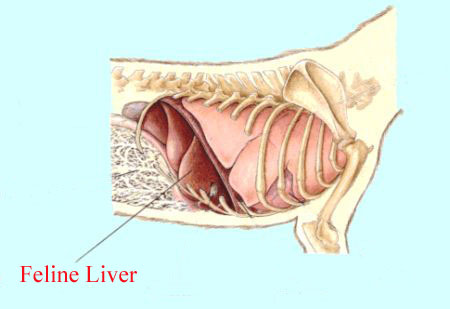CATS
Thomas
Sophie
Becky
Harry
Chloe
George
Polly
Noggy
Charlie
Jessica
Misty
Martha
Amy
Theo
Oscar
Esme
Feral Neutering
Cat Proof Garden
TORTOISES
Shelley
Nancy
Hibernation
HEDGEHOGS
Faithful
Oliver
Bruce
Buster
Uvey
Tiggie
LINKS
HOME PAGE
The word cholangiohepatitis breaks down into “chol” (bile), “angio” (vessel), "hepat" (liver) and “it is”(inflammation). Putting this all together means inflammation of the liver and bile ducts.
You have probably heard of bile ducts but may not really be sure what bile is. Bile is a greenish material that the liver makes, transported to the gall bladder via small bile ducts. The gall bladder is a small greenish sac where bile is stored. When the appropriate hormonal signals are present, the gall bladder contracts and squirts bile into the small intestine via one very large duct called the common bile duct.
Bile has several functions. It emulsifies fat in the diet so it can be
absorbed into the body. It also serves as a
medium to dump toxins that the liver has removed from the body and processed
so they cannot be reabsorbed.
This is a fine system but problems can occur when the bacteria that
live in the small intestine venture up the bile duct and invade the
liver, which is normally sterile (free of bacteria). Inflammation results
and the liver can fail.
Treatment
The cat in liver failure will require hospitalization, fluid therapy,
and some kind of nutritional support (force-feeding, syringe feeding
of a liquid diet or whatever is necessary) regardless of the cause of
the liver disease.
Antibiotics:
Antibiotics are helpful in any liver failure case as they help reduce
the intestinal bacterial populations (any noxious substances they produce
are normally detoxified by the healthy liver but a sick liver will not
be so efficient). Antibiotics also clear the liver of invading bacteria,
which is what cholangiohepatitis is all about. Expect the cat to require
1-3 months of antibiotics after recovery.
Choleretics:
A choleretic is a medication that makes bile more liquid so that it
can flow smoothly without sludging. Flow of bile in the proper direction
helps remove not only the toxins the liver is trying to remove in bile
but also helps prevent bacteria from swimming upstream towards the liver
tissue. Jessica was prescribed Destolit. A cat may well be on this medication
for life after an episode of cholangiohepatitis.
Immune Suppression:
This may seem intuitively inappropriate for a condition that involves
a bacterial infection, but some patients simply cannot get better until
their immune system is suppressed. Why is this? For many cats, the problem
started with Inflammatory Bowel Disease: infiltration of the intestinal
lining with inflammatory cells. Immune suppression is the cornerstone
of therapy for this condition. Once the immune reaction is suppressed,
the lining of the GI tract regains normal thickness and function, the
bacterial bloom subsides, the invasion of the liver and pancreas ceases.
In some cases, immune suppression is simply needed to relieve the inflammation
inherent to cholangiohepatitis. Jessica was prescribed prednisolone.
Outlook
Overall, cholangiohepatitis is one of the more treatable liver conditions
of the cat. This does not mean that every cat will recover; some cats
are quite advanced by the time they are first seen by the veterinarian.
Pancreatitis can represent a lethal complication, depending on severity.
The cat that survives the acute episode can expect long term medication
administration and the possibility of relapse or flare-up. The owner
should become familiar with Inflammatory Bowel Disease and Pancreatitis
as well.

